Spatial reasoning questions are where many CCAT test-takers lose crucial points, but they're also your biggest opportunity for rapid score improvement. Unlike vocabulary-dependent verbal questions or calculation-heavy math problems, spatial patterns follow visual logic that can be systematically decoded.
Last Updated: November 2025 - This spatial reasoning guide has been updated with additional visual examples and proven solving techniques for 2025.
Here's the reality: spatial reasoning appears in 11 questions per test (22% of your score), but most candidates spend 30-45 seconds per question-far too long for the 15-minute time limit. The difference between struggling and succeeding lies in learning the pattern recognition system that turns these "impossible puzzles" into 15-20 second solutions.
Students who master spatial reasoning typically see 8-12 point score increases because they're no longer guessing on a fifth of the test. More importantly, the cognitive skills you develop-pattern recognition, visual processing, and logical deduction-enhance performance across all CCAT sections.
Why Spatial Reasoning Determines CCAT Success
Spatial reasoning tests your brain's ability to manipulate visual information quickly and accurately. This skill directly correlates with problem-solving ability, making it one of the strongest predictors of job performance across industries.
The Cognitive Challenge:
- Visual Processing: Rapidly identifying shapes, positions, and relationships
- Pattern Recognition: Detecting systematic changes across multiple visual elements
- Mental Rotation: Visualizing how objects transform through space and time
- Selective Attention: Focusing on relevant details while ignoring distractors
The Scoring Impact: Research shows that candidates scoring 85%+ on spatial questions achieve overall CCAT scores 10-14 points higher than those who struggle with visual reasoning. This isn't just about "being good at puzzles"-it's about demonstrating the cognitive flexibility that employers value most.
Why Most People Struggle:
- Trying to solve by "feeling" instead of using systematic approaches
- Not recognizing the three distinct question types requiring different strategies
- Focusing on individual elements instead of overall patterns
- Spending too much time on complex questions instead of identifying solvable ones quickly
The solution is mastering the three core spatial question types that cover 100% of CCAT spatial reasoning questions.
The 3 Core Spatial Question Types You Must Master
Every CCAT spatial reasoning question falls into one of three categories. Learning to identify and approach each type correctly is your foundation for consistent success.
Type 1: Next in Series (4 questions per test)
Format: 4-5 figures showing a progression, find what comes next Core Skill: Pattern continuation and rule identification Time Target: 15-20 seconds per question
Type 2: Odd One Out (4 questions per test)
Format: 5 figures, identify which one doesn't belong Core Skill: Comparative analysis and outlier detection Time Target: 10-15 seconds per question
Type 3: Matrices (3 questions per test)
Format: 3x3 grid with one missing figure, complete the pattern Core Skill: Multi-directional pattern recognition Time Target: 20-25 seconds per question
Each type requires specific strategies, but they all share common elements: systematic observation, hypothesis testing, and quick elimination of wrong answers.
Next in Series: Pattern Continuation Mastery
These questions test your ability to identify how visual elements change systematically across a sequence. Master the progression rules, and you'll solve these faster than any other spatial question type.
The Recognition Method:
- Identify all visual elements (shapes, colors, positions, orientations)
- Track how each element changes from frame to frame
- Test your hypothesis across the entire sequence
- Apply the rule to predict the next frame
Real CCAT Example:
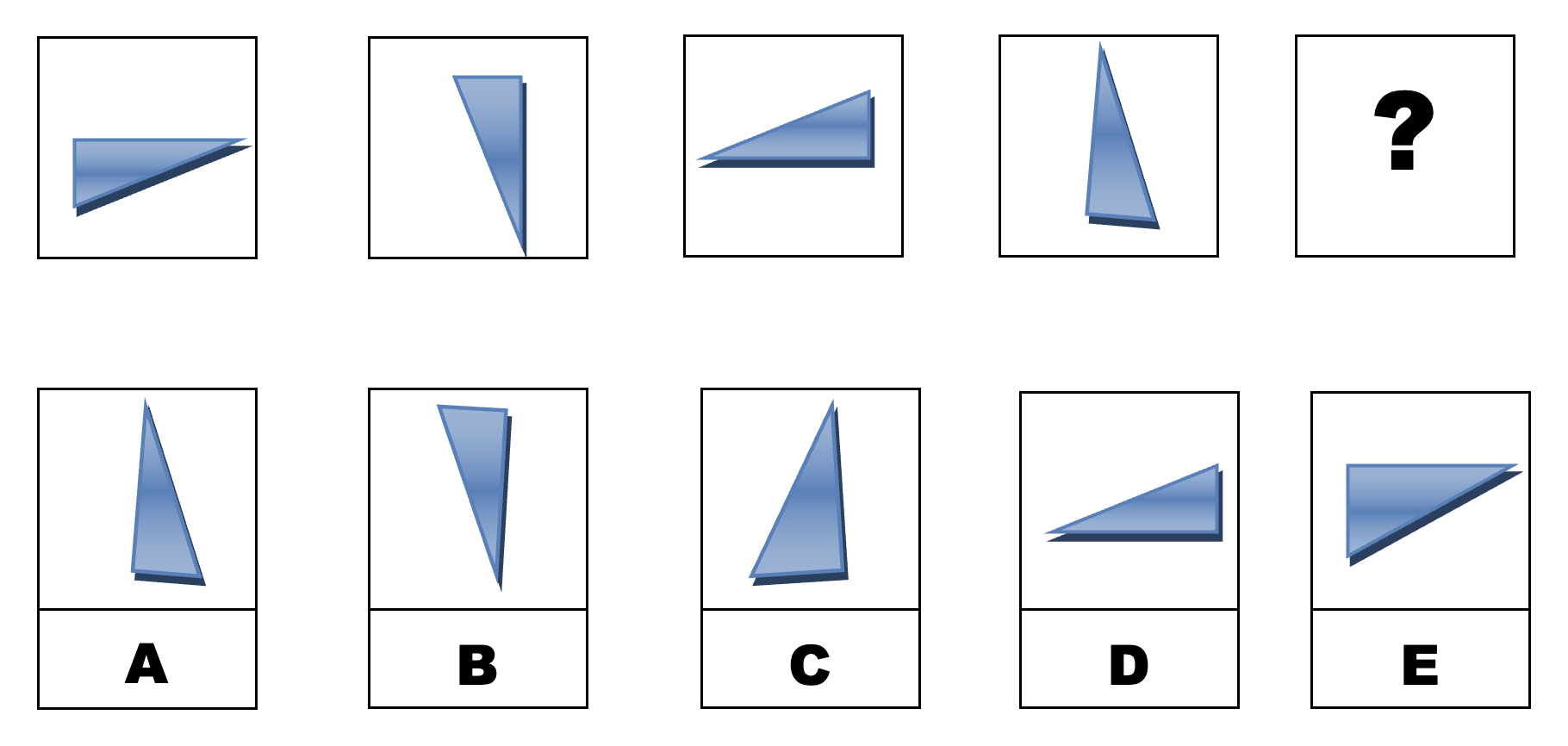
Question: "Which of the following boxes should replace the question mark (?) to complete the pattern?"
The 15-second solution:
- Identify the element (5 seconds): Arrow-like figure changing orientation
- Track the change (5 seconds): Rotates 90° clockwise each step
- Apply the rule (5 seconds): After rotating 270°, next rotation returns to original position
Answer: D - The figure completes the 360° rotation cycle and returns to the starting orientation.
Why this works: The CCAT commonly uses 90° rotation patterns because they test spatial visualization while remaining quickly solvable. Once you recognize this pattern type, similar questions take 10-15 seconds maximum.
Real CCAT Pattern Example 2:
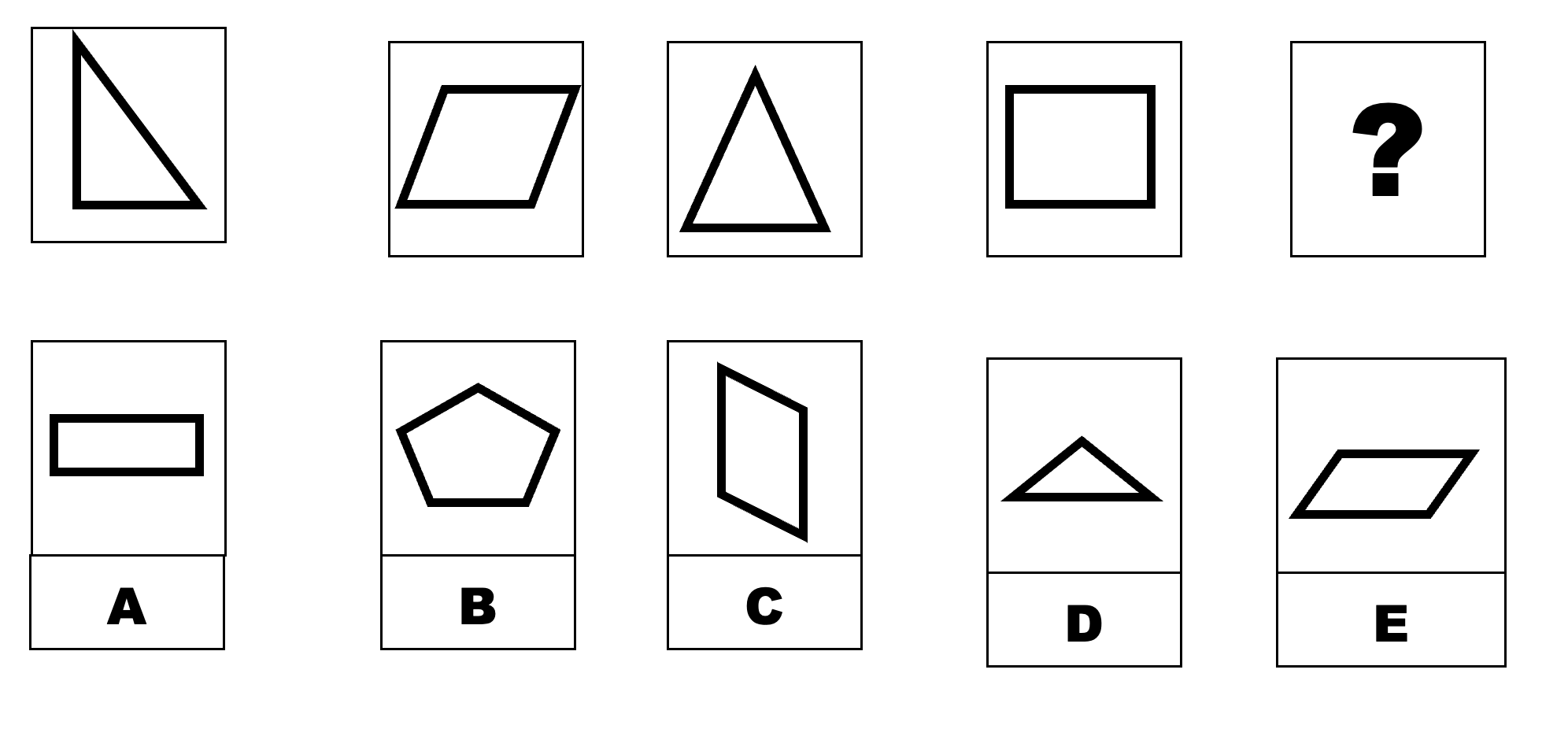
Question: "Which of the following boxes should replace the question mark (?) to complete the pattern?"
The pattern analysis:
- Rule: Alternates between 3-sided and 4-sided figures
- Sequence tracking: Triangle (3) → Square (4) → Triangle (3) → Square (4) → ?
- Next figure: Must be a triangle (3-sided figure)
Answer: D - The only triangle among the options.
Advanced Multi-Element Example:

Question: "Which of the following boxes should replace the question mark (?) to complete the pattern?"
Advanced analysis:
- Key insight: This is an alternating pattern appearing only in odd positions
- Pattern: Parallel arrows rotate 90° clockwise every two steps
- Position tracking: Figure 1 and 3 show the actual pattern, ignore figures 2 and 4
- Solution: Both arrows should point downward in the next odd position
Answer: C - Shows both arrows pointing downward, completing the 90° clockwise rotation.
Pattern Recognition Categories:
Simple Rotation: Object rotates consistently (90°, 180°, etc.) Movement: Object changes position systematically Alternation: Elements switch between two states Addition/Subtraction: Elements are added or removed following a rule Color Changes: Systematic color progression (black→gray→white) Size Changes: Objects systematically grow or shrink
Speed Strategy:
- Always check if only ONE element changes (fastest to solve)
- If multiple elements change, see if they follow the same rule
- Look for 90° rotations first (most common on CCAT)
Odd One Out: Outlier Identification Skills
These questions require comparative analysis across five figures to identify the single different one. The key is systematic comparison using the "characteristic checklist" method.
The Systematic Approach:
- Count elements (number of shapes, lines, etc.)
- Check colors and shading (black, white, gray patterns)
- Analyze positions (where elements are located)
- Examine orientations (how shapes point or rotate)
- Look for symmetry (balanced vs. unbalanced compositions)
Real CCAT Example:

Question: "Which of the following does not belong?"
Quick solution using the systematic approach:
- Count elements: All figures have multiple shapes
- Check colors and shading: Various patterns present
- Analyze positions: Different arrangements in each
- Look for common elements: Notice that 4 figures contain circles
- Identify the outlier: Figure C contains no circle while all others do
Answer: C - It's the only figure without a circle.
Expert Insight: In "does not belong" questions, look for the element that appears in 4 out of 5 figures. The figure missing that element is usually your answer.
Advanced Pattern Examples:
Shape Count Variation:
- Four figures: 3 shapes each
- One figure: 4 shapes
- Answer: The one with different count
Color Pattern Variation:
- Four figures: 2 black shapes, 1 white shape
- One figure: 1 black shape, 2 white shapes
- Answer: The one with reversed color ratio
Orientation Variation:
- Four figures: Triangles pointing up
- One figure: Triangle pointing down
- Answer: The differently oriented one
Symmetry Variation:
- Four figures: Vertically symmetric
- One figure: Asymmetric
- Answer: The asymmetric one
Recognition Shortcuts:
- Visual scanning: Train your eye to spot obvious differences first
- Element elimination: If four figures share an element, focus on the fifth
- Pattern majority: The rule that applies to 4/5 figures is usually correct
Additional Real CCAT "Odd One Out" Examples:
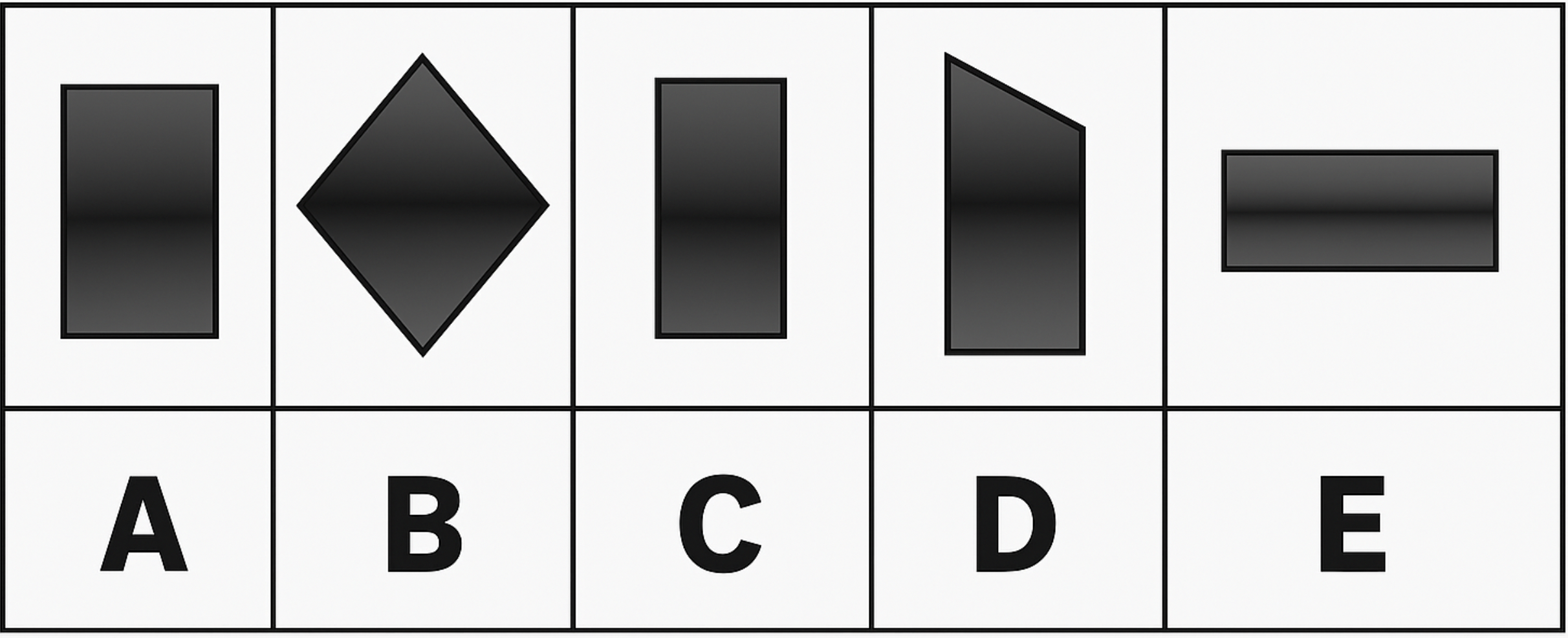
Question: "Which of the following does not belong?"
Systematic analysis:
- Shape counting: Count different types of shapes in each figure
- Pattern recognition: Notice that figures contain squares, rectangles, but only one trapezoid
- Outlier identification: Figure D is the only trapezoid among squares and rectangles
Answer: D - The single trapezoid among multiple squares and rectangles.
Expert Insight: When counting shapes, group similar geometric properties. Squares and rectangles are both four-sided figures with parallel sides, making the trapezoid the clear outlier.
More Advanced Odd One Out:
The database contains multiple examples where you need to count specific elements:
- Circle counting: Four figures have exactly 2 circles, one has 3 circles
- Shading patterns: Four figures follow one shading rule, one breaks it
- Symmetry analysis: Four figures are symmetric, one is asymmetric
Matrices: Multidirectional Pattern Recognition
Matrix questions are the most complex spatial problems on the CCAT, requiring you to identify patterns that work both horizontally and vertically. Success depends on systematic analysis and understanding that most matrices follow 2-3 simultaneous rules.
The Matrix Method:
- Scan rows horizontally for consistent patterns
- Scan columns vertically for consistent patterns
- Identify intersection rules where row and column patterns meet
- Apply combined rules to find the missing figure
Real CCAT Matrix Example 1:
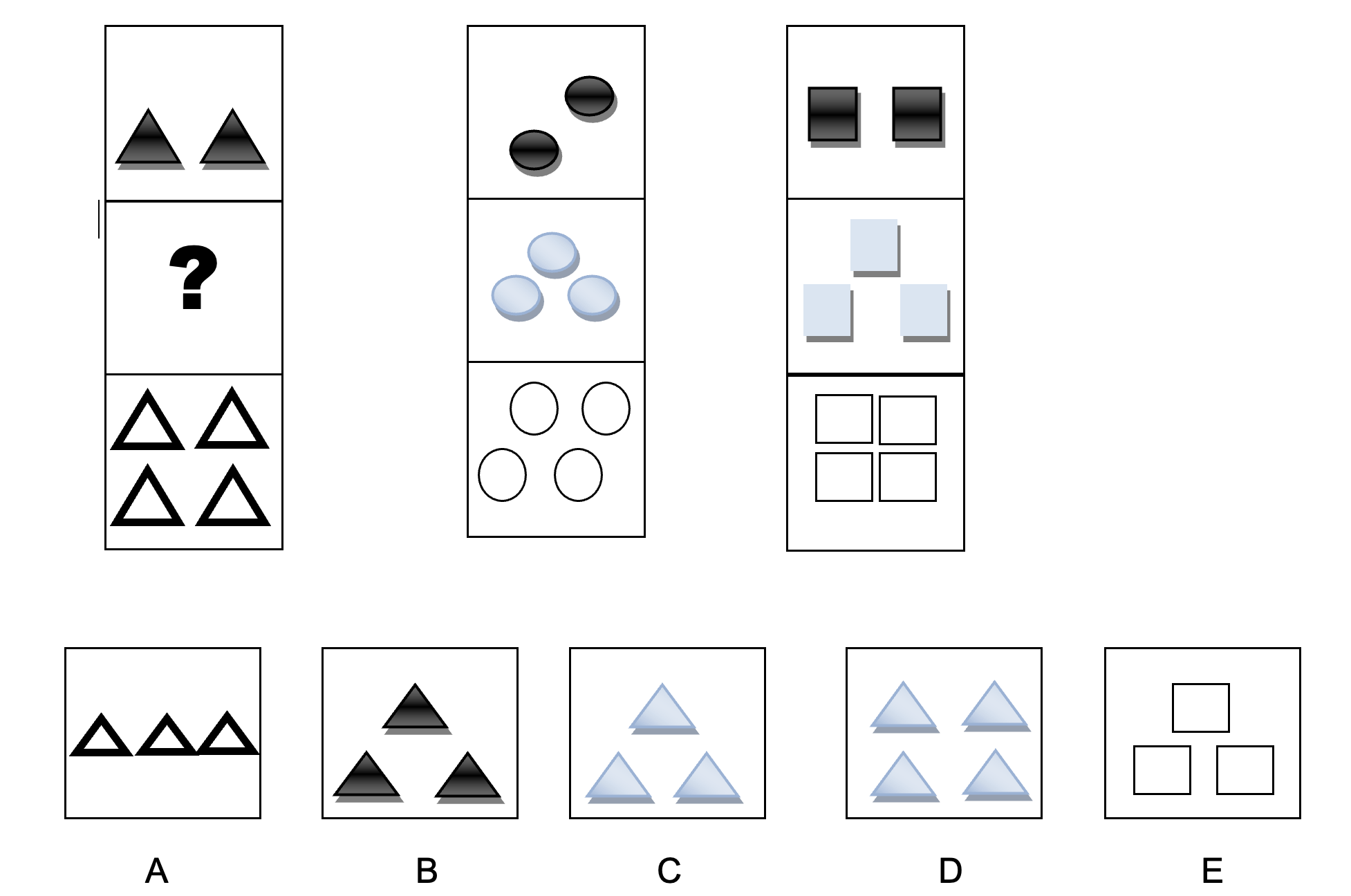
Question: "Which of the following boxes should replace the question mark (?) to complete the pattern?"
Step-by-step matrix solution:
- Row analysis: Row 2 contains three shapes in each figure, all filled with the same color pattern
- Column analysis: Column 1 contains only triangles (different sizes and colors)
- Combined rules: The missing figure must be a filled triangle (satisfying both row and column requirements)
- Answer verification: Only option that meets both criteria
Answer: C - The filled triangle that satisfies both the row pattern (three filled shapes) and column pattern (triangles only).
Real CCAT Matrix Example 2:
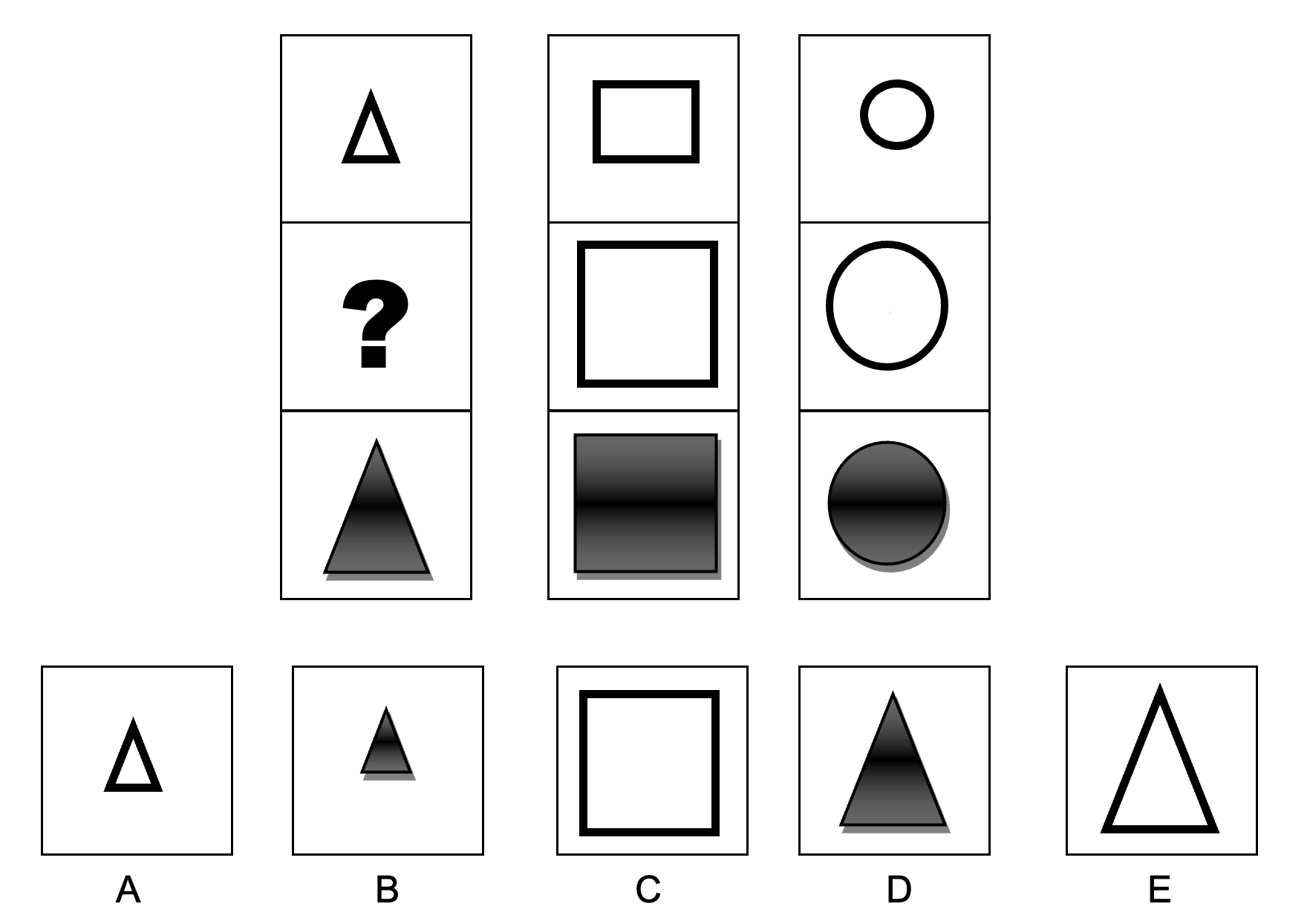
Question: "Which of the following boxes should replace the question mark (?) to complete the pattern?"
Advanced matrix analysis:
- Shape consistency: Column 1 contains only triangles
- Size progression: Notice size patterns across rows and columns
- Fill pattern: Row 2 contains only unfilled (outline) shapes
- Elimination method: Systematically eliminate options that violate any rule
Answer: E - The large unfilled triangle that completes both size and fill patterns.
Common Matrix Patterns:
Shape Progression Rules:
- Each row/column contains different shapes in systematic order
- Shapes appear once per row and once per column (like Sudoku)
- Shape types cycle through predefined sequences
Position Movement Rules:
- Objects move systematically across positions (left→center→right)
- Rotation follows consistent patterns (0°→90°→180°→270°)
- Elements migrate between defined locations
Property Change Rules:
- Colors alternate or progress systematically
- Sizes change in consistent patterns
- Shading follows predictable sequences
Advanced Matrix Example: Complex matrix with multiple simultaneous rules
Analysis approach:
- Isolate one element: Focus on circles only, ignore other shapes
- Track that element: How do circles behave across rows and columns?
- Add second element: Now include triangles, find their pattern
- Combine rules: Apply both patterns to determine missing figure
Bonus Real CCAT Example - Advanced Rotation:
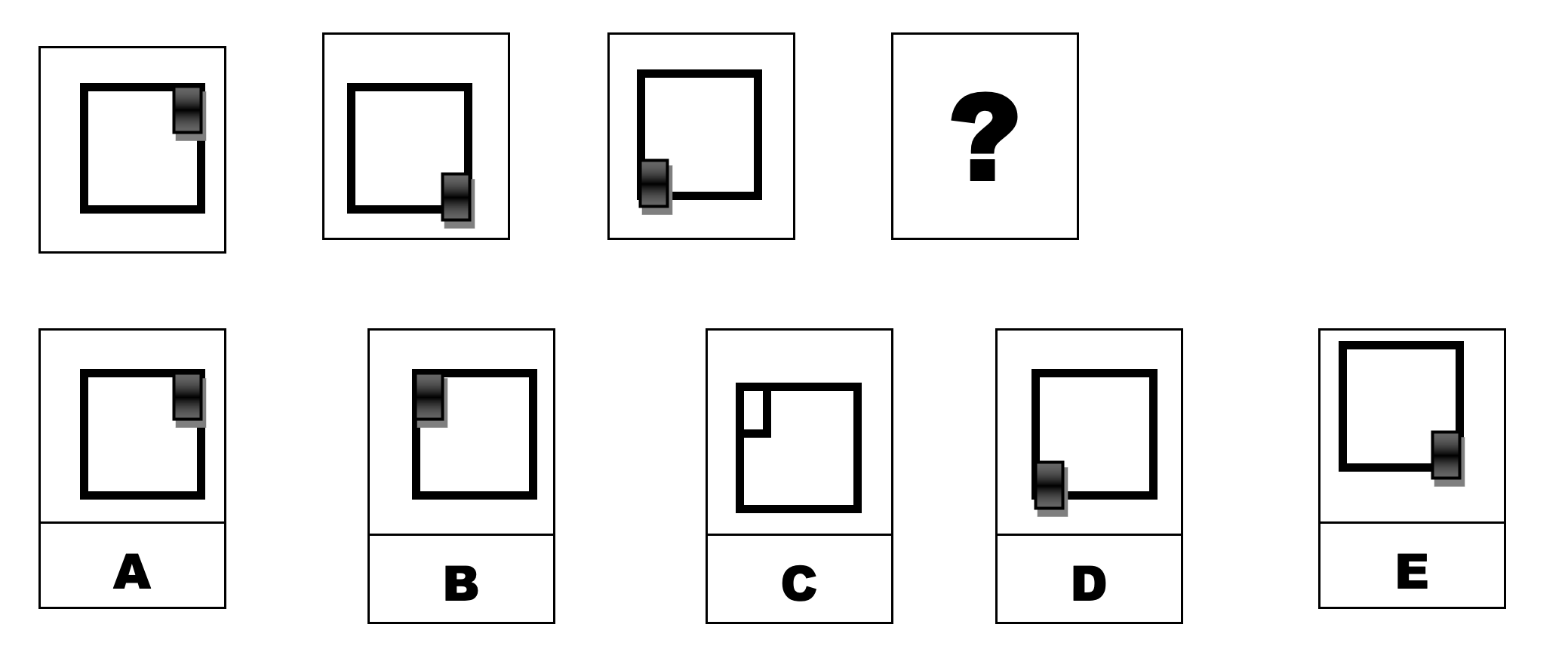
Question: "Which of the following boxes should replace the question mark (?) to complete the pattern?"
Advanced pattern recognition:
- Element tracking: Focus on the shaded rectangle's position
- Movement rule: Rectangle moves 90° clockwise around the perimeter each step
- Position sequence: Top-right → Bottom-right → Bottom-left → Top-left (next)
- Systematic application: Apply the rotation rule consistently
Answer: B - Shows the rectangle in the top-left position, completing the clockwise rotation cycle.
Practice with Real CCAT Questions: All the images above represent actual questions from our CCAT Practice Test database. When you take our Free CCAT Practice Tests, you'll encounter these exact question types with immediate explanations of the solving techniques. This hands-on practice with real CCAT materials is what helps students improve their scores by 8-12 points on average.
Matrix Solving Tips:
- Start with the simplest visible pattern (often position or color)
- Ignore complex elements initially-focus on one pattern at a time
- Use elimination-cross out answers that violate any established rule
- If stuck, try working backward from answer choices
The 15-Second Visual Solving Framework
Use this systematic approach for every spatial reasoning question to maximize speed and accuracy:
Seconds 1-3: Question Type Identification
- Next in Series: Look for sequence arrows or progression
- Odd One Out: Look for five similar figures
- Matrix: Look for 3x3 grid with missing element
Seconds 4-8: Pattern Recognition
- Next in Series: Identify which elements change and how
- Odd One Out: Use characteristic checklist (count, color, position, orientation)
- Matrix: Scan one direction first (rows or columns)
Seconds 9-12: Rule Application
- Apply identified pattern to predict answer
- Use elimination to remove obviously wrong choices
- Double-check rule works for entire sequence/set
Seconds 13-15: Final Verification
- Verify your answer follows all identified rules
- If uncertain between two options, choose simpler pattern
- Move on confidently to next question
Emergency Protocol (if stuck at 10 seconds):
- Eliminate answers that are obviously different in style/complexity
- Look for the most "similar" answer to the given figures
- Make educated guess and move on-don't sacrifice other questions
Advanced Spatial Reasoning Shortcuts
Once you've mastered the basics, these advanced techniques will help you solve complex spatial questions even faster:
The Single-Element Focus Method: Instead of tracking all elements simultaneously, isolate one element and follow it completely through the pattern. This works especially well for matrices and complex sequences.
Example: In a busy matrix, focus only on black circles. Ignore everything else until you understand how black circles behave across rows and columns.
The Opposite-Pattern Recognition: Sometimes it's easier to identify what ISN'T changing rather than what is.
Example: In a sequence where shapes rotate, colors change, and positions shift-but size stays constant-focus on the constant element to eliminate wrong answers quickly.
The Corner-Strategy for Matrices: Start analysis with corner elements (top-left, top-right, bottom-left) because they typically show the clearest pattern initiation points.
The Symmetry-Breaking Analysis: For Odd One Out questions, look for symmetry patterns. Often four figures will be symmetric and one will break the symmetry rule.
Pattern Difficulty Recognition: Learn to quickly assess question difficulty:
- Easy (10-15 seconds): Single element changes, simple rotation/movement
- Medium (15-20 seconds): Multiple elements, clear systematic rules
- Hard (20+ seconds): Complex interactions, multiple simultaneous rules
Strategic Question Selection:
- Scan all spatial questions quickly when you reach them
- Solve easy ones first to build confidence and save time
- Return to harder questions with remaining time
Common Spatial Traps and Mistakes
Understanding what to avoid can save you valuable time and prevent costly errors:
Mistake #1: Overcomplicating Simple Patterns Many test-takers look for complex rules when simple ones work perfectly.
Example Trap: Sequence shows triangle rotating 90° each time, but you theorize about color changes and position shifts that don't exist. Solution: Always test the simplest hypothesis first.
Mistake #2: Focusing on Irrelevant Details Spatial questions often include visual "noise"-elements that don't affect the pattern.
Example Trap: Matrix has complex background patterns that remain constant while simple shapes follow the actual rule. Solution: Train yourself to identify which elements are actually changing.
Mistake #3: Not Checking Answers Against ALL Rules In matrices especially, your answer must satisfy both row AND column patterns.
Example Trap: Finding an answer that completes the row pattern but violates the column pattern. Solution: Always verify your answer works in all directions.
Mistake #4: Getting Stuck on Impossible Questions Some spatial questions are designed to be extremely difficult and time-consuming.
Recognition: If you can't identify ANY pattern after 20 seconds of focused analysis. Solution: Make educated guess and move on-other questions may be easier.
Mistake #5: Misreading Visual Information Under time pressure, it's easy to misperceive shapes, colors, or orientations.
Prevention Strategy: Take one extra second to carefully observe before starting analysis.
Common Visual Misreads:
- Confusing similar shapes (hexagon vs. octagon)
- Missing subtle color differences (dark gray vs. black)
- Misperceiving orientations (which way arrow points)
- Overcounting or undercounting elements
Building Spatial Intelligence Through Practice
Spatial reasoning is one of the most trainable cognitive abilities. With focused practice, you can dramatically improve your performance within 2-3 weeks.
Week 1: Pattern Type Mastery
- Day 1-2: Next in Series only (20 problems daily)
- Day 3-4: Odd One Out only (20 problems daily)
- Day 5-6: Matrices only (15 problems daily)
- Day 7: Mixed practice and timing
Week 2: Speed Development
- Timed sessions: 10 questions in 3 minutes
- Progressive challenge: Start with easy patterns, advance to complex
- Error analysis: Review every mistake to identify pattern gaps
- Speed techniques: Practice the 15-second framework
Week 3: Integration and Simulation
- Mixed question types without knowing which type is coming
- Full test simulation including spatial reasoning sections
- Pressure training: Practice with background noise/distractions
- Final review: Solidify recognition shortcuts
Daily Practice Structure:
- Warm-up (5 minutes): 5 simple Next in Series questions
- Skill building (10 minutes): Focus on one pattern type
- Speed challenge (5 minutes): Timed mixed questions
- Review (5 minutes): Analyze mistakes and reinforce successful strategies
Beyond Formal Practice:
- Environmental awareness: Notice patterns in architecture, floor tiles, wallpaper
- Gaming: Play puzzle games like Tetris, pattern-matching apps
- Visualization exercises: Practice mentally rotating everyday objects
- Drawing practice: Sketch geometric patterns and progressions
Use Our Practice Platform: Take advantage of our Free CCAT Practice Tests which include:
- Spatial reasoning questions with detailed visual explanations
- Time tracking specific to spatial question types
- Pattern recognition tutorials and examples
- Adaptive difficulty that matches your skill level
Remember: Spatial reasoning improvement follows a predictable curve. Most people see significant gains in the first week, with continued steady improvement through practice. The cognitive skills you develop-visual processing, pattern recognition, and systematic analysis-will benefit you not just on the CCAT, but throughout your career in problem-solving roles.
The key is consistent, focused practice with immediate feedback. Master these three question types, and you'll transform spatial reasoning from a weakness into a major strength on test day.

